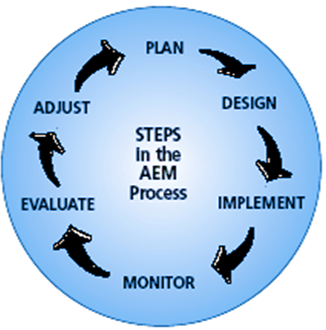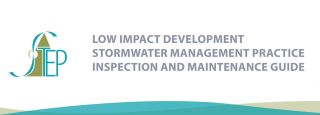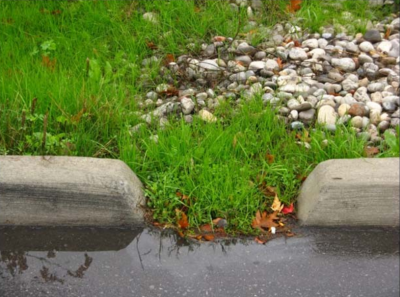Monitoring
Overview[edit]
An inspection and monitoring program is a fundamental part of implementing stormwater management plans and operating facilities. The program evaluates whether a stormwater management practice or system is constructed and functioning according to design and meets the environmental and public health and safety objectives it was designed to meet.
Detailed inspections and monitoring during and after project implementation also help identify potential problems before they grow into larger issues and provide project management staff with opportunities to learn from mistakes and improve processes and designs in future projects. This process of continuous learning and improvement is often referred to as ‘adaptive management’ which ‘promotes flexible decision making that can be adjusted in the face of uncertainties as outcomes from management actions and other events become better understood’ (this can be seen in the image above).
It is important to view inspections and monitoring as part of a single program that strives to meet overlapping goals and shares the same overarching objective of continuous learning and improvement. Key types of inspections and monitoring initiatives include:
- Construction inspections: These inspections are conducted by qualified staff just prior to construction of stormwater feature and at intervals throughout construction corresponding to major milestones such as the completion of excavation, connection of drainage pipes, media placement, etc. Approved erosion and sediment control plans and site/feature design drawings provide the benchmark against which construction outcomes are evaluated.
- Assumption inspections: These inspections assess whether the stormwater management practice has been constructed in accordance with the design drawings and that approved design modifications (if any) meet expectations. These inspections are conducted after substantial completion of construction prior to the beginning of the ‘warranty period’ (typically 2 years), and again at the end of the ‘warranty period’ and prior to final assumption of ownership by the municipality or owner.
- Routine operation and verification inspections: These inspections are conducted by maintenance crews after assumption of the facility and are typically followed by various maintenance tasks identified as necessary to restore the visual appeal of the practice and ensure any functional issues are addressed. Routine Inspections occur at regular intervals throughout the year, while verification inspections entail more detailed assessments conducted periodically (e.g. every 5 years) to evaluate whether minor or major repairs are needed to rehabilitate overall system function.
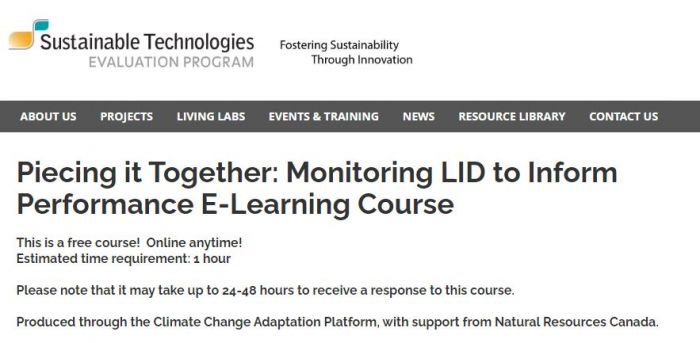
.
- Functional monitoring: This type of monitoring is often conducted with continuous measurement devices (e.g. water level sensors, water temperature sensors) over a period of time to evaluate the function of the system during and after rain events. Typical functional monitoring parameters may include inlet and outlet function, surface and subsurface water level changes, overflow frequency and soil moisture/salinity conditions (see below for more details). Functional monitoring may occur any time after substantial completion of construction. Conducting functional monitoring during the warranty period can simplify and/or replace the tasks needed for assumption inspections, since the former can be regarded as a more detailed form of an assumption inspection.
- Performance monitoring: This monitoring evaluates how well a stormwater management feature or management measure performs in comparison with a range of performance indicators or design targets (e.g. peak flow attenuation, volume reduction) to determine whether design criteria has been met and to compare how this practice performs relative to other stormwater facilities, technologies and/or development contexts. This more detailed monitoring would typically occur after the development site has been stabilized either before or after site assumption by the municipality or owner. Conducting performance monitoring after substantial completion of construction can replace and/or simplify the tasks typically undertaken through both functional monitoring and assumption inspections because performance monitoring involves a wide range of detailed measurements, including many of the same measurements undertaken through simpler inspection and monitoring programs.
- Environmental effects monitoring: This monitoring is designed to assess the cumulative impact of land use changes and stormwater management measures on groundwater, terrestrial system and/or the environmental health of a stream reach, subwatershed, watershed, or individual community. Understanding environmental effects requires quantifying key sources of hydrologic and chemical changes within the contributing drainage area, monitoring the major management measures put in place to mitigate land use changes, and evaluating changes in physical, chemical and biological indicators of the environmental systems of interest (e.g. groundwater, receiving waters, terrestrial systems). Where budget is limited, an environmental effects monitoring program may be scoped to evaluate impacts on a limited range of environmental variables (e.g. stream health, groundwater contamination).
Inspections[edit]
Detailed guidance on the various types of inspections required as part of a comprehensive inspection and maintenance plan is provided on the wiki inspection and maintenance page here:
Monitoring[edit]
Unlike centralized stormwater management facilities, the LID approach involves the installation of many smaller stormwater management practices distributed across the landscape. Therefore, it is often not cost effective to conduct functional and/or performance monitoring of every practice.
For this reason, an effective monitoring program will ensure that all practices undergo the inspections detailed above, but only representative practices are selected for continuous functional and/or performance monitoring. Since functional monitoring is relatively simple and cost effective to undertake, it may be applied to a larger number of features than would be possible if more quantitative data on performance was required. Detailed performance monitoring should be reserved only for new technologies or new configurations of practices for which local data on performance is lacking.
Stormwater practices suitable for 'functional monitoring' may include ones that:
- Have underground drainage pathways that may not be captured through visual inspections;
- Have undergone design modifications during construction that may have influenced system function;
- Were identified during visual inspections as having potential deficiencies;
- Could benefit from additional monitoring to refine planned maintenance programs or elucidate system response and function during rain events of varying size.
Stormwater practices that may be suitable for 'performance monitoring' may include:
- New technologies for which detailed monitoring data are needed to verify performance against design criteria and/or provide information on potential design improvements for future site applications;
- Technologies or series of technologies configured or installed in a unique way for which detailed monitoring data are needed to understand performance;
- Projects designed as a pilot demonstration with specific learning outcomes that could be transferred to future sites with similar technologies or management measures.
Functional Monitoring[edit]
The purpose of functional monitoring is to verify that stormwater is being conveyed through the stormwater management technology as expected, and that other non-hydrologic objectives of the practice (e.g. plant survival, temperature mitigation, aesthetics) are being satisfactorily achieved. It is differentiated from performance monitoring in that the measurements are relatively simple and cost effective. As such, they are not intended to provide precise quantitative values that can be compared to design criteria such as outflow release rates and suspended solids removal. Examples of continuous functional measurements in LID practices during rain events may include:
Measurement type |
Stormwater practice type |
Purpose of Measurement |
Required equipment |
|---|---|---|---|
| Surface Ponding | Bioretention Cells, Rain garden, Bioswale, Enhanced grass swales | Measures duration and depth of surface ponding relative to design objectives. Indicates whether media infiltration rates and ponding durations meet expectations. Indicates size and intensity of rain events causing overflow if the overflow pipe is on the surface. | Water level sensor(s) installed on the soil surface |
| Subsurface water level fluctuations | Bioretention Cells, Rain garden, Bioswale, Enhanced grass swales, Permeable pavements, Infiltration chamber | Provides a rough measurement of infiltration rates into native soils for full and partial infiltration systems. | Water level sensor(s) installed in wells or access manholes |
| Catch basin water level fluctuations | Stormwater Tree Trenches | Indicates whether water is flowing freely from the CB through the perforated distribution pipe. If an overflow pipe is located in the CB, water fluctuation measurements will indicate frequency of overflows | Water level sensor in the inlet catch basin |
| Water level fluctuations | Wet ponds, constructed wetlands, OGS, Filtration MTDs, Rainwater Cisterns | Indicates whether design stage discharge curve is achieved in practice. Larger than expected water level fluctuations (i.e. long drawdown times) may indicate outlet clogging. Also, measurements may indicate size/intensity of rain events causing overflow or bypass. | Water level sensor(s) installed below permanent pool |
| Temperature | All practices for which thermal mitigation may be a concern (e.g. ponds, cooling trenches, etc.) | Indicates change in water temperature from the inlet to outlet, as well as the absolute outflow temperature relative to design targets. In some instances, the difference in temperature from the top to bottom of the practice may also be of interest as this can influence dissolved oxygen levels and chemical stratification and release. | Water temperature sensor at the inlet and outlet. Sensors at different depths in the facility to determine how different designs may influence thermal stratification. |
Other in-situ measurements of interest in functional monitoring may include plant growth/survival, inlet/outlet water quality grab samples, surface infiltration in selected areas and various visual observations similar to those included in assumption inspections.
Performance Monitoring[edit]

Performance monitoring measures how well (or poorly) a management practice or stormwater management facility performs relative to design objectives and targets. Performance monitoring programs are typically undertaken when little information is available regarding the effectiveness of a certain type of facility in a certain environmental context, or when a new technology is being implemented for the first time within a certain context or geographic region.
Performance monitoring programs differ from functional monitoring in that they typically require detailed measurements of a wide range of parameters that often provide information above and beyond what would be required to determine whether the facility meets minimum regulatory requirements.
New or emerging technologies need to be assessed in terms of their performance in order to gain acceptance by review and approval agencies. Performance monitoring is also needed to develop a better understanding of how the design of conventional end-of-pipe facilities can be adapted when LID practices are implemented upstream as part of a treatment train approach. The Sustainable Technologies Evaluation Program (STEP) provides detailed performance data on a wide range of stormwater management practices. The types of equipment typically employed in performance monitoring of stormwater management facilities may include automated samplers or continuous water quality sondes, water level sensors, flow meters or structures (e.g. weirs, flumes), soil moisture/salinity sensors, tipping bucket rain gauge(s), temperature sensors and other equipment tailored to the specific project monitoring program goals. Central data loggers may be used to collect multiple sources of sensor data to simplify data analysis and interpretation. See the resource section below for more detailed literature on stormwater performance evaluation methods, instrumentation options, quality control procedures and data analysis methods.
Environmental Effects Monitoring[edit]
In the field of stormwater management, the purpose of environmental effects monitoring is to evaluate the effectiveness of stormwater management measures in mitigating impacts of land use practices on the health of groundwater, watercourses and terrestrial systems. While performance monitoring assesses the effectiveness of stormwater management measures or treatment trains, environmental effects monitoring takes the analysis a step further by assessing the extent to which these management measures help meet their ultimate objective of improving the health of aquatic, groundwater and terrestrial systems.
The scale of environmental effects monitoring may be at the stream reach, subwatershed, watershed or community scale. Sites must be carefully selected to ensure that the impact of stormwater management measures that are being assessed have the potential to have a significant impact on the receiving watercourse. In practice this means that runoff from the assessed drainage area represents at least 50% of total flow within the receiving water system (otherwise system response to land use changes and/or management measures may be difficult to detect with statistical significance).
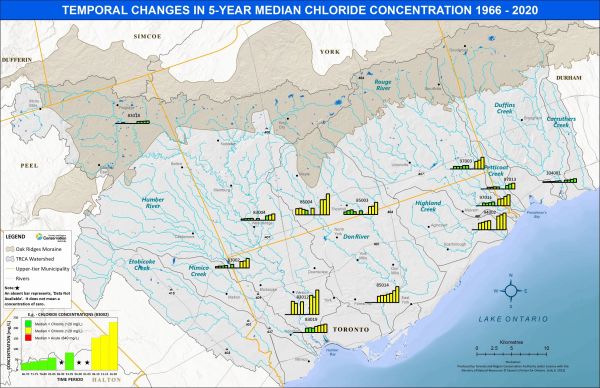
In addition to detailed assessments of receiving water health, environmental effects monitoring should also include monitoring of significant point sources of contaminants as well as major stormwater management practices treating water discharged to the area of interest. This allows for meaningful relationships to be developed between contaminants sources, management measures and environmental conditions. In addition to precipitation and air temperature, general environmental parameters that may be measured in environmental effects studies may include those listed in the table below:
Discipline Name |
Area of Focus |
Example Indicator |
|---|---|---|
| Hydrogeology | Groundwater | baseflow and groundwater levels |
| Hydrology | stream flow regimes | temporal trends, time series flows |
| Terrestrial Natural Heritage | forests, meadows, wetlands, shorelines and their flora and fauna, | quantity of natural cover, vegetation communities |
| Fluvial Geomorphology | stream form and channel shaping processes | channel stability, Rapid Geomorphic Assessment (RGA protocols) |
| Water Quality | water chemistry, benthic invertebrate species, populations and communities | parameters of concern, community composition |
| Aquatic Biology | fish species, populations and communities | Index of Biotic Integrity, Ontario Stream Assessment Protocol (OSAP) protocols |
Conservation Authorities have established networks of regional environmental monitoring stations with data extending back several decades. These data sets can be helpful to establish baseline stream health indicators for environmental effects monitoring programs and assess trends over time. An example of the data collected at these monitoring stations by TRCA's Watershed Planning and Ecosystem Science team can be seen in the image above depicting 5-year median concentrations of chloride found in the CA's watershed.
Resources[edit]
Performance monitoring[edit]
- Consultants, Wright Water Engineers Inc., 2009. Urban Stormwater BMP Performance Monitoring.
- US EPA, 2006. Data Quality Assessment: Statistical Methods for Practitioners.
- Washington Department of Ecology, 2018. Technology Assessment Protocol – Ecology (TAPE): Technical Guidance Manual.
- TRCA, 2023. Canadian Procedure for Field Testing of Filtration Manufactured Treatment Devices. Publicly Available Specification.
References[edit]
- ↑ STEP. 2016. Low Impact Development Stormwater Management Practice Inspection and Maintenance Guide. https://sustainabletechnologies.ca/app/uploads/2016/08/LID-IM-Guide-2016-1.pdf
- ↑ STEP. 2018. Improving nutrient retention in bioretention. Technical brief. Accessed: https://sustainabletechnologies.ca/app/uploads/2019/06/improving-nutrient-retention-in-bioretention-tech-brief.pdf
- ↑ TRCA. 2021. Spatial Patterns (2016-2020) and Temporal Trends (1966-2020) in Stream Water Quality across TRCA’s Jurisdiction. Prepared by Watershed Planning and Ecosystem Science. October, 2021. https://sustainabletechnologies.ca/app/uploads/2021/10/2016-2020-SWQ-Report-v11_FINAL_AODA-FA.pdf
